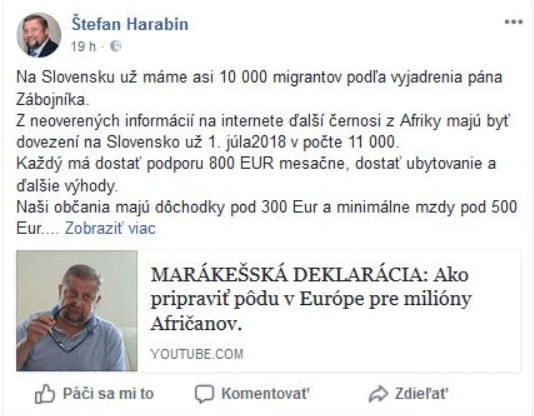Current Events II
Slovak Presidential Elections 2019
This year Slovakia held presidential elections. The
goal of this entry is to analyze the elections through the lens of fake news,
conspiracies, disinformation and propaganda. In case these phenomena did
intervene in the elections, the main questions are, who were the candidates
that were the main subjects of disinformation, what was the nature of the
disinformation, and who distributed it?
An analysis of 649 Facebook entries regarding presidential
elections posted by 14 most relevant fake news channels has been published in
a combined study by STRATPOL, MEMO98, SSPI and GLOBSEC (Kandrík,
Kužel, Masariková, & Sawiris, 2019). According to Kandrík et al. most
influential of these channels were Hlavné správy, Hrica Lubos, InfoVojna, ĽUBOŠ
BLAHA and Sila Pravdy. The
analysis suggests that 208 of the disinformation posts had a positive tone and
84% of them were specifically associated with presidential candidate Štefan
Harabin. On the other hand, the most frequent target of disinformation anti-campaigns
was presidential candidate Zuzana Čaputová.
Kandrík et al. (2019) also managed to identify ten most frequent narratives of the analyzed fake news subjects, which are:
- Traditional media cannot be trusted (61 entries),
- Liberalism undermines stability of the society (58 entries),
- Traditional values are endangered (religion, family) (55 entries),
- Interventions in the election process (54 entries),
- Conspiracies and hidden interests (52 entries),
- Nationalism (52 entries),
- Anti-LGBTI agenda (39 entries),
- Anti-EU narrative (33 entries),
- Corruption and oligarchs' influence (27 entries),
- Migration as a threat (24 entries) (p. 6).
Apart from many of the items listed being direct appeals to fear, in my opinion the most note-worthy narrative is "traditional media cannot be trusted". On one hand it is important for us to be critical towards information since the history has taught us that even traditional media can be subject to propaganda, but on the other hand, this is a very dangerous path to follow, becuase it gives unprofessionals a tool to make amateurish desisions about credibility of information. As a result, the society becomes more vulnurable to disinformation, since suddenly it is within all people's ability to determine what is true and what is not based on appeals rather than reason.
Let's now take a look at some specific examples of disinformation from the presidential campaign. The first one is a theory by Ľuboš Blaha that presidential candidate Zuzana Čaputová was being financed by influential Jews with connections to the American government (Ižák, 2019, March 16). Blaha is by the way a member of the parliament and a notorious disseminator of disinformation.
Another example is a collage created by Facebook page IdemVolit.sk, where Čaputová is depicted as having connections to influential American financier of Jewish descent George Soros as well as the American Embassy and other organizations that allegedly stood behind Čaputová (Ižák, 2019, March 16).
Ižák (2019, March 16) also emphasized that Čaputová's links to Jewish conspiracies were not only established through Soros. In fact, magazine Zem a vek (Transl. The Earth and Age) used in one of their articles a picture of Čaputová with a photoshopped nose as to imply a connection to Jews.
Unlike Čaputová, who was frequently a subject of anti-campaign by conspiratorial channels, Harabin was not only supported by these media, but he himself was often a dissemitator of mendacious information. As an example, in May 2018 Harabin was spreading false information that there were already 10,000 immigrants in Slovakia (Ižák, 2019, February 12). Moreover, Harabin was scaring people with an unverfied piece of information that another 11,000 black immigrants were to be sent to Slovakia and were all to be given accomodation and 800 euros per month.
Let's now take a look at some specific examples of disinformation from the presidential campaign. The first one is a theory by Ľuboš Blaha that presidential candidate Zuzana Čaputová was being financed by influential Jews with connections to the American government (Ižák, 2019, March 16). Blaha is by the way a member of the parliament and a notorious disseminator of disinformation.
Another example is a collage created by Facebook page IdemVolit.sk, where Čaputová is depicted as having connections to influential American financier of Jewish descent George Soros as well as the American Embassy and other organizations that allegedly stood behind Čaputová (Ižák, 2019, March 16).
 |
| Image 2: Conspiratorial collage created by Facebook page IdemVolit.sk (Ižák, 2019, March 16). |
 |
| Image 3: Depiction of presidential candidate Zuzana Čaputová in magazine Zem a vek (Ižák, 2019, March 16). On the left is the actual picture, while on the right is the photoshopped version. |
 |
| Image 4: Presidential candidate Štefan Harabin spreading disinformation about immigrants on his Facebook profile (Ižák, 2019, February 12). |
Finally, the presidential elections in Slovakia were eventually won by Zuzana Čaputová. Nevertheless, conspiratorial webs' favorite, Štefan Harabin, made it as far as the third place and is currently attempting to succeed in the parliamentary elections. Based on this analysis it can be assumed that disinformation in Slovakia regarding politcs is not only quite vocal but also quite significant. Although disinformation has not caused any dramatic political consequences so far, I believe it will be necessary to take measures regarding political disinformation in the future, as it appears to be a serious threat to democracy.
References
Ižák,
Š. (2019, February 12). Ako je to s pravdovravnosťou Štefana Harabina?
Retrieved from https://antipropaganda.sk/ako-je-s-pravdovravnostou-stefana-harabina/
Ižák,
Š. (2019, March 16). Dezinformácie a konšpiračné teórie v slovenskej
prezidentskej kampani 2019. Retrieved from https://antipropaganda.sk/dezinformacie-konspiracne-teorie-v-slovenskej-prezidentskej-kampani-2019/
Kandrík,
M., Kužel, R., Masariková, M, & Sawiris, M. (2019). Prezidentskí kandidáti v médiách, pp. 6-7. Retrieved from https://www.globsec.org/wp-content/uploads/2019/03/Prezidentski-kandidati-v-mediach.pdf

Komentáre
Zverejnenie komentára